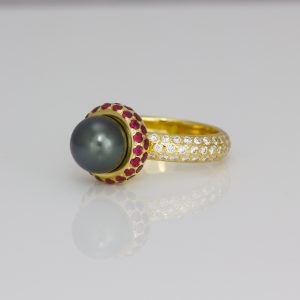Pearl
Pearls all you need to know, a buyers guide to pearls
Technically an organic substance, produced by shelled molluscs, concentric layers of calcium carbonate.
I’ll discount imitation pearls at this point, generally made from plastic or glass, easily distinguished, due to the lack of gritty texture. As with all gemstones beware of anything described as “real”.
Pearls all you need to know, a buyers guide to pearls

Pearls have been treasured and used in jewellery for centuries, traditionally found only in nature, spontaneously formed in oysters, protecting themselves from a parasitic irritant, not as generally thought, a grain of sand.
Until the early 20th century, the only way of finding pearls was to dive down to the ocean floor. A dangerous job, divers were often forced to dive down over 100 ft in a single breath, needing to collect over a ton oysters to find 3 or 4 quality pearls.
Natural pearls are as they have always been very rare, Cleopatra is said to have consumed one in a glass of wine, to prove to Marc Anthony she could consume the wealth of a nation in a single meal. I have heard it said a famous jeweller traded a string of natural pearls he’d been collecting for his building on 5th Avenue, New York; a figure of $1,000,000 is often quoted as the value, back in 1917.
Most pearls that we see today are cultured. Cultured pearls are to all intentions the same material as natural pearls, but the irritant is placed in the molluscs rather than by chance in nature. Think of cultured pearls as farmed pearls. Originally produced by Mikimoto in Japan in the Early 1920’s, having spent many years unsuccessfully trying to simulate the pearl production. His discovery of the technique of culturing pearls made pearls available and affordable to all. Pearls all you need to know, a buyers guide to pearls
Pearls are now produced in numerous localities around the world, in both fresh and salt water. Until recent times it was easy to tell freshwater from marine pearls, but further developments in production have meant the differences harder to spot.

Like all other materials, the value of a pearl is based on a few things. Obviously if it’s natural or cultured, larger stones generally demand a higher price, the surface finish, shape, colour, and how deep the luster all contribute to the price. The luster in a pearl is also called orient, as I understand the longer the time between being nucleated and harvested, and the cleaner the water, the higher the luster. The percentage of pearls that are the highest of all the criteria is small with many having a multitude of surface imperfections, amorphic shapes and a chalky luster, some find these attractive, but the more “perfect” the higher the price. I only use AAA pearls
Pearls are only 2.5 – 4.5 on the mohs scale, so not ideal for an engagement ring, but make classic cocktail rings, or perfect for necklaces and ear studs. I always recommend that perfumes of hairsprays be put on before pearls, as they can affect the luster leaving it chalky.

Save
Save
Save
Save

